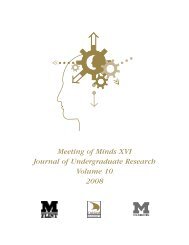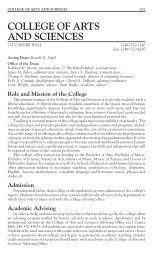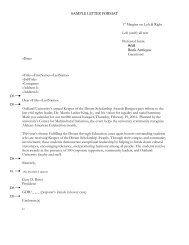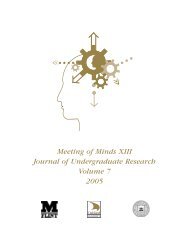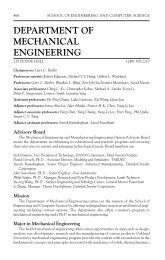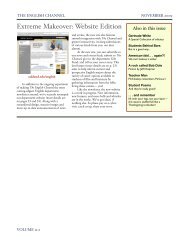MOM 2006 journal for pdf.pmd - University of Michigan-Flint
MOM 2006 journal for pdf.pmd - University of Michigan-Flint
MOM 2006 journal for pdf.pmd - University of Michigan-Flint
You also want an ePaper? Increase the reach of your titles
YUMPU automatically turns print PDFs into web optimized ePapers that Google loves.
MUTE HEROINES<br />
Adela Levis<br />
Faculty Sponsor: Christopher Clason<br />
Department <strong>of</strong> Modern Languages, Oakland <strong>University</strong><br />
By the end <strong>of</strong> the nineteenth century, the fairy tales collected by the Grimm brothers were<br />
already recognized <strong>for</strong> their pedagogical value. They do not only entertain us, but also teach us<br />
how to behave in many situations, that challenge our courage, character, and values. Jack Zipes<br />
explains, in his book, “Fairy Tales and The Art <strong>of</strong> Subversion”:<br />
Reading as a physical and mental process involves identification be<strong>for</strong>e an<br />
internalization <strong>of</strong> norms and values can commence, and identification <strong>for</strong> a<br />
child comes easily in a Grimm’s fairy tale…Thus, direct identification <strong>of</strong> a<br />
child with the major protagonist begins the process <strong>of</strong> socialization<br />
through reading (57).<br />
The recurring themes in the tales are those <strong>of</strong> fearless heroes and princesses in distress. But what<br />
happens when girls and women read these tales? If fairy tales teach us about how to behave and<br />
about values and morals, then isn’t it strange to want our female children to identify with a<br />
passive and powerless female hero? The Grimms’ tales too <strong>of</strong>ten prescribe gender roles, and only<br />
rarely challenge them. Maria Tatar confirms this, in the following excerpt from her book “The<br />
Hard Facts <strong>of</strong> the Grimms’ Fairy Tales”:<br />
Wilhelm Grimm felt obligated to stamp the tale’s actors with his own<br />
character judgments and thus shaped this reader’s views <strong>of</strong> them. That we<br />
are <strong>for</strong>ever coming across wise monarchs, compassionate heroes, toiling<br />
beauties, and proud princesses has something to do with folkloric plot<br />
patterns, but it also has a great deal to do with Wilhelm Grimm’s<br />
preconceived notions about sex, class, and character (30).<br />
The fairy tales “The Twelve Brothers” and “The Goose-Maiden”, at first sight seem to present<br />
some very women-friendly, even feminist tendencies, but under closer scrutiny they reveal a<br />
much different side. Both portray female protagonists, but in neither tale does the protagonist<br />
take on an active role, in deciding over her fate. The “evil”, ironically, is in both tales represented<br />
by female characters, although the first glance does not necessarily reveal the factual situation.<br />
Another theme connecting the two tales, is the silencing <strong>of</strong> the two characters; Bottingheimer<br />
states that one hardly needs scientific pro<strong>of</strong> to prove the annoyance that men have with women<br />
who talk. She observes that in one <strong>of</strong> the most famous fairy tales about the siblings “Hansel and<br />
Gretel”, the brother’s first words to his sister are, “Quiet, Gretel”. Hansel also speaks more <strong>of</strong>ten,<br />
and <strong>for</strong> a longer time than Gretel (51). The two tales discussed in this essay support this theory:<br />
The sister in the “Twelve Brothers” can only release her brothers from a magic spell, by not<br />
making a sound <strong>for</strong> seven years. And the goose maiden is threatened with death, if she speaks<br />
about the theft <strong>of</strong> her identity. Communication through language <strong>for</strong>ms a large part <strong>of</strong> what<br />
Meeting <strong>of</strong> Minds <strong>2006</strong> 98



